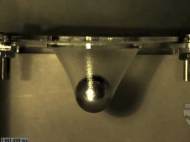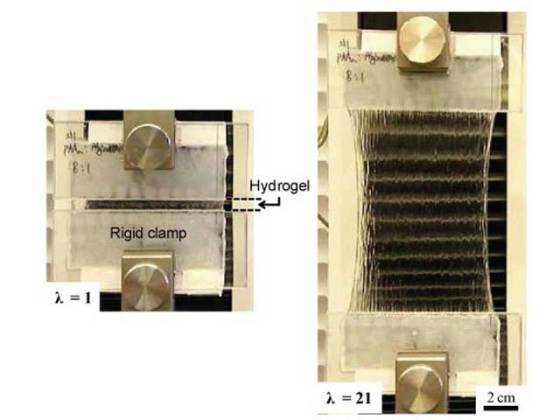Biocompatible hydrogel could be used as cartilage replacement
 A team of experts in mechanics, materials science, and tissue engineering at Harvard School of Engineering and Applied Sciences (SEAS) have created an extremely stretchy and tough hydrogel which is a hybrid of two weak gels that combine to create something much stronger. This new gel can stretch up to 21 times of its original length, but it is also exceptionally tough, self-healing, and biocompatible.
A team of experts in mechanics, materials science, and tissue engineering at Harvard School of Engineering and Applied Sciences (SEAS) have created an extremely stretchy and tough hydrogel which is a hybrid of two weak gels that combine to create something much stronger. This new gel can stretch up to 21 times of its original length, but it is also exceptionally tough, self-healing, and biocompatible.
“Conventional hydrogels are very weak and brittle—imagine a spoon breaking through jelly”, said Jeong-Yun Sun, a postdoctoral fellow at the Harvard SEAS and lead author of the study. “But because they are water-based and biocompatible, people would like to use them for some very challenging applications like artificial cartilage or spinal disks. For a gel to work in those settings, it has to be able to stretch and expand under compression and tension without breaking.”
To create the new hydrogel, the researchers combined two common polymers – polyacrylamide, known for its use in soft contact lenses and as the electrophoresis gel that separates DNA fragments in biology labs, and alginate, a seaweed extract that is frequently used to thicken food.
Although both of these gels are weak on their own, when combined in an 8:1 ratio the two polymers form a complex network of crosslinked chains that reinforce one another. The chemical structure of this network allows the gel to stretch instead crack.
The alginate portion of the gel consists of polymer chains that form weak ionic bonds with one another, capturing calcium ions (added to the water) in the process. When the gel is stretched, some of these bonds between chains break—or “unzip,” as the researchers put it—releasing the calcium. As a result, the gel expands slightly, but the polymer chains themselves remain intact. Meanwhile, the polyacrylamide chains form a grid-like structure that bonds covalently (very tightly) with the alginate chains.
Therefore, if the gel acquires a tiny crack as it stretches, the polyacrylamide grid helps to spread the pulling force over a large area, tugging on the alginate’s ionic bonds and unzipping them here and there. The research team showed that even with a huge crack, a critically large hole, the hybrid gel can still stretch to 17 times its initial length.
The new hydrogel is capable of maintaining its elasticity and toughness over multiple stretches. Provided the gel has some time to relax between stretches, the ionic bonds between the alginate and the calcium can “re-zip” and the researchers have shown that this process can be accelerated by raising the ambient temperature.
The material, its properties, as well as a simple method of its synthesis open up new opportunities in medicine and tissue engineering. Aside being used as artificial cartilage, the Harvard SEAS researchers suggest that the new hydrogel could be used in soft robotics, optics, artificial muscle, as a tough protective covering for wounds.
For more information, read the paper published in Nature: “Highly stretchable and tough hydrogels”.










So many breakthroughs in this field, but there are efforts to actually use these technologies in actual practice…